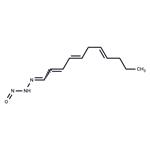Triacsin C (76896-80-5) is a long-chain fatty acyl CoA synthetase inhibitor (IC50=3.6-8.7 μM).1?Inhibits mouse macrophage-derived foam cell formation2 and displays anti-atherosclerotic activity3. Cell permeable.
Triacsin, a fatty acyl CoA synthetase inhibitor, reduces myocardial infarct size, attenuates loss of post-reperfusion cardiac function, increases intravascular nitric oxide (NO) concentration, and inhibits leukocyte recruitment. Triacsin C analogs can also be used as potential antivirals against rotavirus infections.
ChEBI: Triacsin C is a nitroso compound that is N-undecylnitrous hydrazide carrying double bonds at positions 1,2,4, and 7. It is a long-chain fatty acyl CoA synthetase inhibitor and interferes with lipid metabolism by inhibiting the de novo synthesis of glycerolipids and cholesterol esters. It has a role as an EC 6.2.1.3 (long-chain-fatty-acid--CoA ligase) inhibitor, a vasodilator agent, an apoptosis inhibitor, a bacterial metabolite, an EC 3.1.1.64 (retinoid isomerohydrolase) inhibitor and an antimalarial. It is a nitroso compound, an olefinic compound and a hydrazone.
Triacsin C belongs to a family of fungal metabolites all having an 11-carbon alkenyl chain with a common N-hydroxytriazene moiety at the terminus.
Triacsin C is a potent inhibitor of long-chain fatty acyl CoA synthetase. It blocks β-cell apoptosis, induced by fatty acids (lipoapoptosis) in a rat model of obesity. In addition, it blocks the de novo synthesis of triglycerides, diglycerides, and cholesterol esters, thus interfering with lipid metabolism.
1) Hartman et al. (1989), Triacsin C: a differential inhibitor of arachidonoyl-CoA synthetase and nonspecific long chain acyl-CoA synthetase; Prostaglandins, 37 655
2) Namatame et al. (1999), Complete inhibition of mouse macrophage-derived foam cell formation by triacsin C; J. Biochem, 125 319
3) Matsuda et al. (2008), Anti-atherosclerotic activity of triacsin C, an acyl-CoA synthetase inhibitor; J. Antibiot. (Tokyo), 61 318

